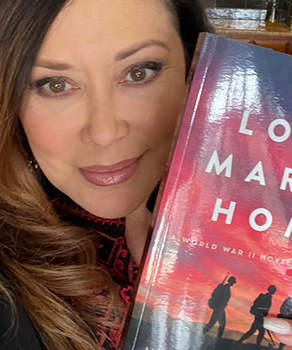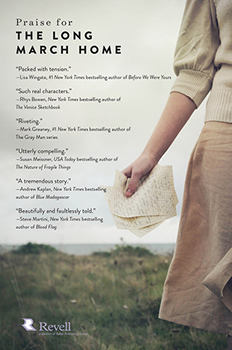

Features Up Close: Tosca Lee and Marcus Brotherton
A Coming of Age Story Set in the Philippines
 By Wendy Tyson
By Wendy Tyson
Called a “[A] tour de force” by Publishers Weekly (starred review) and “A must-read literary triumph” by Booklist (starred review), THE LONG MARCH HOME, written by Marcus Brotherton and Tosca Lee, is a thrilling and poignant coming-of-age story set in the Philippines during World War II.
When Jimmy Propfield joins the army with his two best friends, he wants to forget his high school sweetheart and leave Mobile, Alabama behind. At first. the Philippines seems like paradise, but the exotic appeal of the South Pacific soon wears off when the Japanese bomb Pearl Harbor. Suddenly, the boys find themselves thrust into the midst of a world at war. Inspired by true stories, THE LONG MARCH HOME follows Jimmy and his friends while they face the brutal reality of combat and embark on a four-year fight for survival.
The original idea for THE LONG MARCH HOME came from Marcus Brotherton who began working on the story between his contracted books. “About six years ago,” Lee says, “[Marcus] called me up and asked if I was interested in joining him. I knew Marcus, I had endorsed his award-winning novel, Feast for Thieves, and was familiar with his WWII nonfiction, and he had read several of my books. But I had not heard of the harrowing chapter of WWII history known as the Bataan Death March.” The more Lee learned about the Bataan Death March, the more she knew she wanted to be involved in this project. “‘Let’s do it,’ I said. What an honor it has been to share the story of the Defenders of Bataan and shine a light on these heroes.”
At its core, THE LONG MARCH HOME is a novel about friendship, sacrifice, and the amazing power of faith and hope. In this exclusive interview, The Big Thrill talks with Tosca Lee about an extraordinary novel and its long journey to publication.
THE LONG MARCH HOME was a joint project between you and Marcus Brotherton, who wrote Voices of the Pacific and We Who Are Alive and Remain: Untold Stories from the Band of Brothers, among others. How did you handle the logistics of writing such an ambitious novel together?
This is my second time co-authoring, and the process has been very different than the first. Essentially, Marcus sent over everything he had, including his early manuscripts, and told me to have at it. If you ask me, this open-handed approach is rare, and I’m so grateful for his trust in me as a writer and as someone who would honor this history.
I started to research (and if you know me, you know how crazy I am about research) and finally dug in. I added a new front, a backstory that makes this book a dual timeline…and five years to the process. This is a novel 12 years in the making between the two of us.
In the end, we passed it back and forth, compromised on a lot, honored one another’s non-negotiables, and trusted in these things: the strengths we each brought to the partnership; the value of rewriting (and rewriting…and rewriting again…); and the importance of humor.
The book is set in the Philippines during World War II and deals with the atrocities committed there, including the notorious Bataan Death March. What special research did you do to get the setting and historical details right? Were there any particular research challenges you and Marcus had to overcome?
We spent a lot of time in the first-person accounts of survivors. Marcus has interviewed some of these men in person, although there are fewer and fewer of them remaining today. The detail in these survivor accounts—and so many of them never spoke about what they endured until late or even very late in life—is incredible. For my part, I spent quite a lot of time digging into the logistics of the battles, where these men came from, when and how they arrived in the Philippines, the training they received, what they drank and where they went clubbing or to the movies during their leisure time. Marcus found a fascinating record of a historical female guerrilla named Felipa Culala, who appears in the book. Also, the details of these boys’ lives growing up in 1930s Mobile, Alabama.
Probably the biggest challenge was just the horror of the things that occurred. Reading about the awful conditions, the torture, hunger, disease…it’s a miracle anyone survived.
THE LONG MARCH HOME is at its heart a coming-of-age novel about three teenagers from Mobile, Alabama who find themselves far from home during a tumultuous time. Please tell us a little about Jimmy Propfield and his best friends, Billy and Hank. Without spoilers, what events from Jimmy’s past helped make him the person he is when we first meet him in THE LONG MARCH HOME? Why did you choose this character to tell this story?
Jimmy is our main character. He’s a good kid who always tries to do the right thing. He and Claire, Billy’s older sister, have been companions practically since birth, as their mothers are best friends.
Billy, who is a couple years younger than Jimmy, is the happy-go-lucky sidekick.
Hank, the oldest of the boys, is a natural leader, a bad boy, and the kind of kid others want to be around. The only problem is, Hank’s had a soft spot for Claire since meeting her in third grade…and Claire is the only girl Jimmy’s ever loved.
Jimmy is interesting as a main character because he goes from a world where right and wrong are easy to discern to a world filled with so many moral gray areas, he no longer knows right from wrong—a world in which the rules no longer make sense, and what keeps you alive one day is completely different from what sustains you the next. Where true morality has little to do with rules at all.
The book opens with a letter sent to Jimmy by his childhood sweetheart, Claire, giving the reader an immediate sense of sweet innocence and an impending sense of innocence lost. Indeed, loss is a theme in the book, as is friendship. What other themes emerged as you wrote THE LONG MARCH HOME? How are some of these themes reflected in the setting and the circumstances in which Jimmy and his friends find themselves?
Absolutely, the loss of innocence. But it’s also a redemptive tale. The entire story is about sacrifice on many levels. For Jimmy, it’s the sacrifice of a dream future that doesn’t seem meant to be. For Billy, it’s the sacrifice of what could have been a college career as a track star. For Hank, it’s about claiming—and laying down—his own chance to shine after living so long in the spotlight of his older brother, Cowboy. For all three of them, it’s about doing whatever it takes to keep their friends alive.
We see the uncertainty—of the future, of knowing what’s right—in the chaos of war and jungles of Bataan. And we encounter the innocence in the nostalgia of growing up in 1930s Alabama.
What’s next for each of you?
Marcus is in the midst of a book with a celebrity, and I’m delving deeper into the past with a new medieval thriller.
- Up Close: Tosca Lee and Marcus Brotherton - May 2, 2023
- Up Close: J. T. Ellison - February 28, 2023
- Up Close: J. J. Hensley - September 30, 2020





